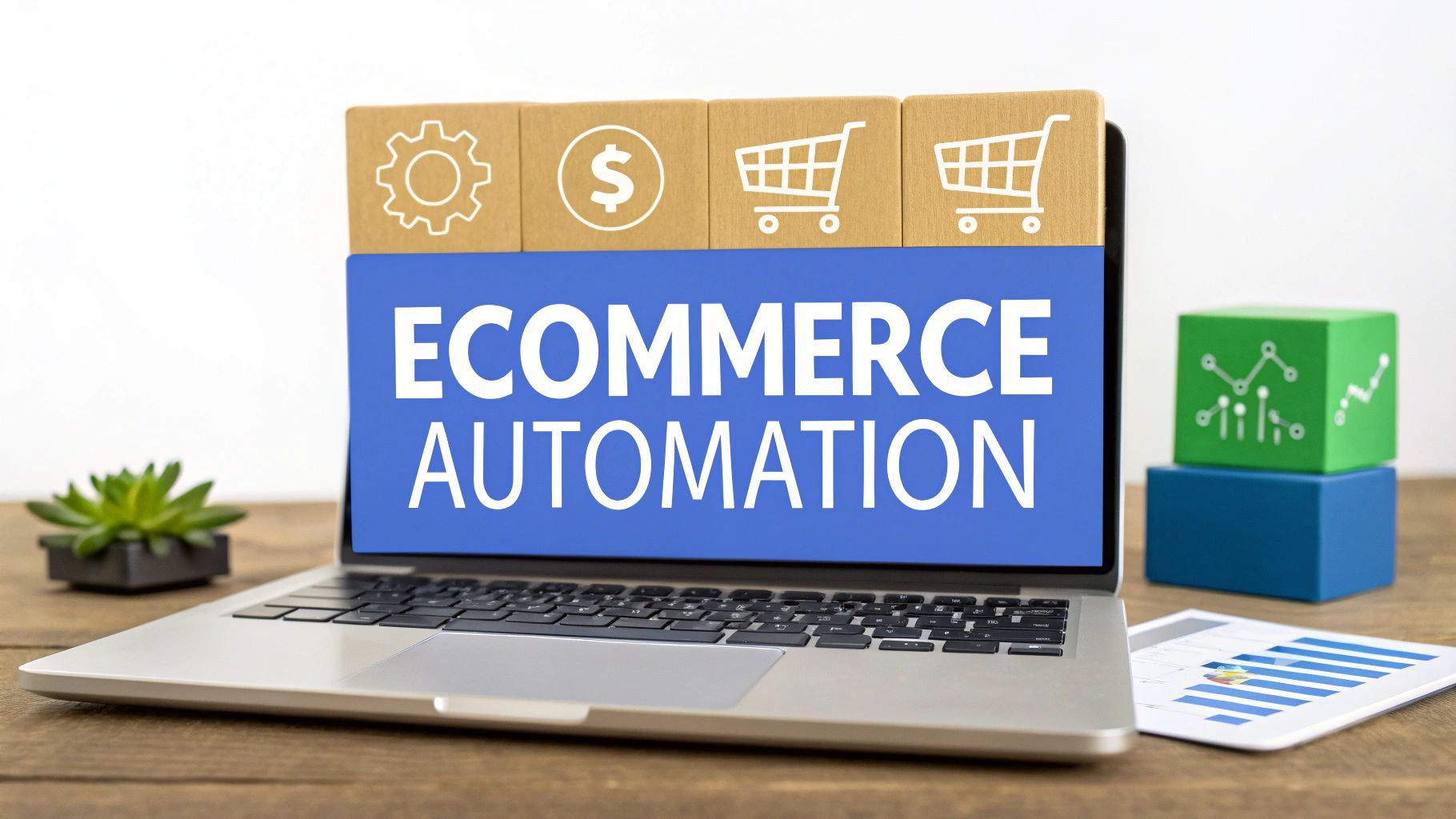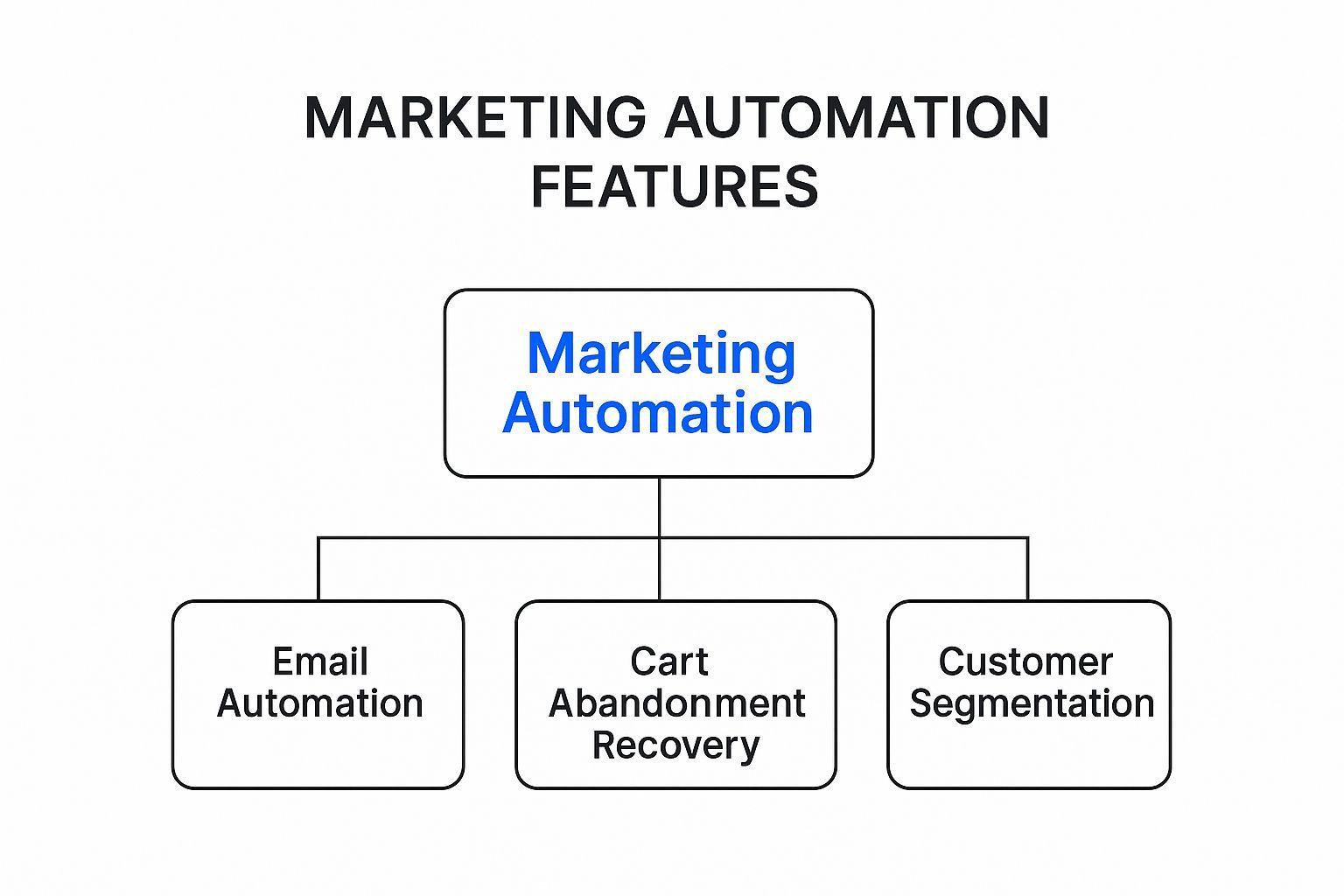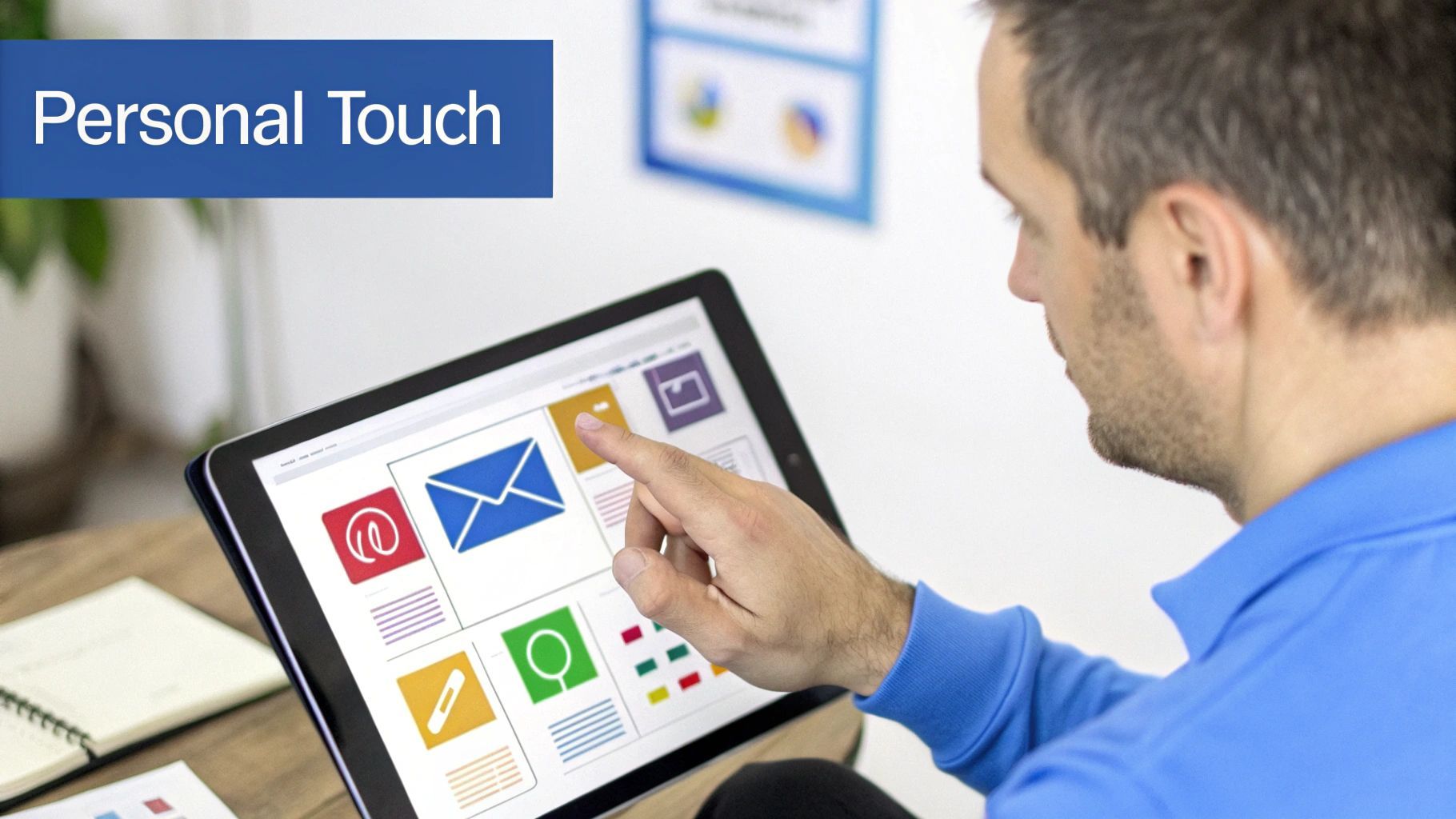
Your Guide to Ecommerce Marketing Automation
Discuss with AI
Get instant insights and ask questions about this topic with AI assistants.
💡 Pro tip: All options include context about this blog post. Feel free to modify the prompt to ask more specific questions!
Picture this: you have a sales assistant who works around the clock, never sleeps, and knows exactly what to say to every single customer at just the right moment. That’s the essence of ecommerce marketing automation. It’s not about sending generic blasts; it’s about using smart software to handle repetitive marketing jobs, so you can deliver personal messages that resonate with your shoppers.
At its heart, marketing automation is the engine driving modern ecommerce. Instead of you or your team manually sending every welcome email, abandoned cart reminder, or birthday discount, the software does it for you.
Think of it like a series of digital tripwires you set up across your online store. When a customer takes a specific action—like signing up for your newsletter, looking at a product three times, or adding something to their cart—they trip a wire. This instantly triggers a relevant, pre-planned message designed just for that moment.
This completely changes the game. Marketing stops being a list of manual, one-off tasks and becomes a seamless, automated journey for every shopper. You’re able to deliver a highly personal experience at a scale no human team could ever hope to match.
It’s no wonder the marketing automation industry is projected to hit a value of $15.62 billion by 2030. Businesses are seeing real money from it, too, earning an average of $5.44 for every $1 spent. And with AI now powering about 77% of the content creation in these platforms, they're only getting smarter. You can dive deeper into these trends and discover insights on marketing automation statistics.
The real magic happens when you connect these automated actions to real-world results. This isn't just about saving a few hours a week. It’s about creating timely, meaningful touchpoints that drive sales and build genuine customer loyalty.
The goal isn't to replace the human touch but to scale it. Automation ensures every customer receives timely, relevant communication that feels personal, whether you have 100 customers or 100,000.
This direct link between a customer's behavior and your response is what makes automation so powerful. Let's break down how specific triggers lead to real business outcomes.
The table below shows exactly how a customer's action can trigger an automated response that helps your business grow. It’s a simple "when this happens, do that" formula that produces measurable results.
Customer Trigger (The 'When') Automated Action (The 'What') Business Impact (The 'Why') A visitor subscribes to a newsletter. An automated welcome email series is sent with a first-time buyer discount. Builds an immediate relationship, encourages the first purchase, and increases conversion rates. A shopper leaves items in their cart. A sequence of reminder emails or SMS messages is sent over several days. Recovers potentially lost sales, directly boosting revenue from interested buyers. A customer makes their second purchase. The system automatically segments them into a "repeat buyer" list and sends a thank-you note. Enhances customer loyalty, increases lifetime value, and opens doors for future VIP offers. A customer hasn't purchased in 90 days. A "win-back" campaign is triggered with a special, limited-time offer. Re-engages dormant customers, prevents customer churn, and drives incremental sales.
As you can see, each automated workflow is a direct response to a customer’s needs at a specific point in their journey.
Ultimately, ecommerce marketing automation is the bridge that keeps the conversation going between your brand and your customers. It empowers businesses of any size to deliver the kind of sophisticated, one-on-one marketing that was once reserved for only the biggest players in the game.

Let's be clear: ecommerce marketing automation isn't just about sending a few emails on a schedule. It's a fundamental change in how you run your store, tackling the biggest headaches that come with growth. The real value isn't just saving time—it's about building a smarter, more profitable, and customer-focused business from the inside out.
Think about it. As your store gets bigger, personally welcoming every new subscriber or checking in with every customer becomes impossible. Automation steps in as your digital team member, ensuring every single shopper gets the right message at the right time. It makes them feel noticed, whether you have 100 customers or 100,000.
This one shift sends ripples through your entire operation, turning tedious manual tasks into powerful strategic assets.
One of the first things you'll notice is the relief. Your team is suddenly free from the soul-crushing grind of repetitive work. Forget the hours wasted exporting lists, manually sending follow-ups, or wrestling with spreadsheets to figure out who bought what.
Automation takes over the boring but necessary jobs, like sending welcome emails, post-purchase thank-yous, and "we miss you" campaigns. This frees up your people to focus on what actually drives growth. Instead of just reacting to the day's tasks, they can finally be proactive.
With the repetitive work off their plate, your team can focus on what people do best: shaping your brand's voice, dreaming up brilliant campaigns, analyzing trends, and finding new ways to make customers happy.
It’s this leap from manual labor to strategic thinking that unlocks real growth, allowing a small team to perform like a much larger one.
Consistent, relevant communication is the foundation of loyalty. People don't just want personalization anymore; they expect it. In fact, almost half of shoppers are more likely to spend more when they feel an experience is tailored to them. Automation makes that personal touch possible for everyone.
A simple automated birthday email with a special discount, for instance, is more than just a marketing tactic. It’s a small, human gesture that says, "We see you," and strengthens the bond a customer has with your brand.
Here are a few ways automated touchpoints create loyal fans:
- Post-Purchase Check-ins: An automated email asking "How are you enjoying your new gadget?" shows the relationship doesn't end when the credit card is charged. It's a simple move that boosts satisfaction and often leads to great reviews.
- Re-Engagement Campaigns: When a loyal customer goes quiet, a friendly, automated "Hey, it's been a while!" email with a compelling offer can bring them right back. It’s a low-effort way to keep the customers you worked so hard to win.
- Loyalty Milestones: You can automatically celebrate your best customers when they hit a spending goal or an anniversary with your brand. This makes them feel like valued insiders and keeps them coming back.
These steady, thoughtful interactions turn one-time buyers into genuine brand advocates who spend more and tell their friends about you.
At the end of the day, it all comes down to the bottom line. Ecommerce marketing automation directly impacts your revenue by plugging the leaks where you’d normally lose sales.
The most classic example? The abandoned cart sequence. We know that roughly 7 out of 10 shopping carts are left behind. That's a staggering amount of money just sitting there. An automated series of emails or texts reminding shoppers what they left can recover a huge chunk of that lost revenue.
Beyond just saving sales, automation is a machine for increasing customer lifetime value (CLV). By using purchase history to send smart cross-sell ("You bought the camera, now get the lens!") and upsell recommendations, you increase the average order value and give customers more reasons to shop with you again, boosting what each person is worth to your business over time.
To really get what ecommerce marketing automation is all about, you have to look under the hood. Don't think of it as a single tool, but more like a high-performance engine made of several critical, interconnected parts. Each piece has its own job, but they all hum along together to create personalized experiences that actually drive revenue.
The whole system runs on a simple but incredibly powerful principle: "if this happens, then do that." This is the DNA of every automated campaign. A customer's action (the "if") sets off a pre-planned marketing response (the "then"). This simple logic is what lets you graduate from blasting generic messages to having highly relevant, one-on-one conversations with thousands of customers at once.
Getting a feel for how these parts work together is the first real step toward building a system that feels smart, helpful, and genuinely in-tune with what your shoppers want.
Picture this: you're in a crowded room, trying to have a meaningful conversation by shouting the same thing at everyone. It’s a recipe for failure, right? That’s what marketing without customer segmentation is like. It’s the most important piece of the puzzle—a smart sorting hat for your audience that groups customers into smaller, more specific buckets based on who they are and what they've done.
Without good segmentation, real personalization is just a pipe dream. You can't possibly send the right message if you have no clue who you're talking to. Thankfully, modern platforms go way beyond basic demographics, letting you slice and dice your audience based on their actual behavior.
Here are a few common segments you can build right away:
- New Subscribers: People who just gave you their email but haven't bought anything yet.
- First-Time Buyers: Customers who just made their first purchase and are ready for a great onboarding experience.
- Repeat Customers: Shoppers who have bought from you more than once—a clear sign they like what you're doing.
- VIPs: Your top-tier customers, usually based on how much they spend or how often they buy. These folks deserve the red-carpet treatment.
- Abandoned Carts: Visitors who got this close to buying but bailed at the last second.
- Inactive Customers: People who haven't opened an email or made a purchase in a while (say, 90 days).
By sorting customers this way, you can make sure a new buyer gets a warm welcome series, while a VIP gets an exclusive heads-up about a new product. It’s this targeted approach that makes your marketing feel like a helpful tip, not a pushy sales pitch.
So, if segmentation tells you who to talk to, workflows are the automated playbooks that dictate what to say and when to say it. A workflow is just a sequence of automated actions—like sending an email or an SMS—that kicks off when a customer does something specific or falls into a certain segment.
This is where those "if this, then that" rules come to life. A classic example is the abandoned cart workflow, which might play out like this:
- Trigger: A customer adds items to their cart but doesn't complete the checkout.
- Wait 1 Hour: Send a gentle email reminder: "Did you forget something?"
- Wait 23 Hours: If they still haven't bought, send a second email that creates a little urgency: "Your items are selling out fast!"
- Wait 2 Days: Still no purchase? Send one last email with a friendly nudge, like a 10% discount, to seal the deal.
A big part of building out your automation is managing all the emails, images, and copy that go into these campaigns. This process, often called creative workflow management, is what keeps everything on-brand and ready to deploy at a moment's notice.
This diagram helps show how all these pieces fit together.

As you can see, core features like email automation and cart recovery are all built on the foundation of smart customer segmentation.
The last critical piece of the engine is analytics and reporting. Running an automation system without data is like driving a car blindfolded. Sure, you're moving, but you have no clue if you're headed in the right direction or about to hit a wall. Good analytics close the loop, turning your marketing into a cycle of constant learning and improvement.
Your platform’s dashboard is your command center. It should give you a clear, no-nonsense look at the key performance indicators (KPIs) for every single workflow. You need to be tracking:
- Open Rates: What percentage of people actually opened your email?
- Click-Through Rates (CTR): How many of them clicked on a link?
- Conversion Rates: What percentage did what you wanted them to do (like make a purchase)?
- Revenue Generated: The bottom line—how much money did this specific campaign bring in?
By keeping a close eye on this data, you can make smart, informed decisions instead of just guessing. Is your welcome series not performing well? Time to A/B test a new subject line. Is your abandoned cart flow losing steam after the first email? Maybe you need to tweak the timing. This data-driven mindset is what elevates automation from a simple "set it and forget it" tool to a dynamic growth machine for your brand.
Knowing the building blocks of an automation engine is one thing, but using them to actually make money is where the fun really begins. For most online stores, email workflows are the most direct and profitable way to put automation into practice. These aren't just random emails, but carefully planned sequences that kick in at exactly the right moments in a customer's journey.
The impact of these automated emails is hard to overstate. Research shows that well-executed workflows can pull in up to 30 times more revenue per recipient than your average, one-off email blast. While they typically represent just a tiny slice of all emails sent (around 1.8%), they’re responsible for a whopping 31% of all email-driven sales. It’s the ultimate example of working smarter, not harder. You can dig into the full report on marketing automation performance to see the numbers for yourself.
Let's walk through the most essential workflows you can set up today to start getting these kinds of results.
First impressions matter. A lot. That moment when a new person signs up for your email list is your single greatest chance to turn their curiosity into a real customer relationship. Think of a great welcome series as your automated handshake, brand intro, and first sales pitch all rolled into one.
The goal is straightforward: build trust and gently guide them toward making their first purchase.
- Email 1 (Sent Immediately): Deliver on your promise. If you offered a discount for signing up, give it to them right away. Keep this email simple, with a clear call-to-action focused on using that offer.
- Email 2 (Sent 1-2 Days Later): Tell your story. What makes your brand special? Share your mission, your values, or the "why" behind your business. This helps build an emotional connection that goes beyond just products on a shelf.
- Email 3 (Sent 3-4 Days Later): Show them the proof. Highlight your best-selling products, showcase glowing reviews, and feature testimonials from happy customers. This builds confidence and shows new subscribers what other people already love about your store.
It's a staggering statistic: nearly 70% of all online shopping carts are abandoned. That represents a huge amount of potential revenue just sitting there. An automated abandoned cart sequence is your best weapon for getting those sales back. Remember, these aren't cold leads—they’re people who were this close to buying and just needed a little nudge.
Cart abandonment workflows are the most popular and powerful type of ecommerce automation. They account for 54.2% of all automated setups for a simple reason: they have a direct and immediate impact on your bottom line.
A tried-and-true sequence looks something like this:
- The Reminder (1-3 hours after abandonment): Send a friendly, low-pressure email. A subject line like, "Did you forget something?" is perfect. Sometimes, a simple reminder is all it takes to bring them back.
- The Urgency Nudge (24 hours after): Gently dial up the urgency. Mention that popular items are selling out or that their cart will expire soon. This can motivate anyone who was on the fence to finally take action.
- The Incentive (48-72 hours after): If they still haven't bitten, it’s time to make them an offer they can't refuse. A small discount (10-15% off) or free shipping is often the final push needed to seal the deal.
The customer journey doesn’t stop once the payment goes through. In fact, what you do after the sale is often what turns a one-time buyer into a lifelong fan. An automated post-purchase follow-up is your key to building loyalty, gathering priceless feedback, and driving repeat business.
This workflow engages customers when they're most receptive—right after they've bought from you.
- Order Confirmation (Immediately): This email is transactional, but it doesn't have to be boring. Make it more than a receipt. Thank them sincerely and reassure them that they made a great decision.
- Shipping Confirmation (When the order ships): Let them know their goodies are on the way! This builds anticipation and excitement. Always include a tracking link to make their life easier.
- Review Request (7-14 days after delivery): Ask for their thoughts on the product. Timing is everything; give them enough time to actually use it. Those positive reviews are gold for social proof.
- Cross-Sell/Upsell (21-30 days after): Now that they’ve had a good experience, suggest something else they might love. Did they buy a new coffee maker? Now's the perfect time to recommend your best-selling beans.
It's natural for some customers to go quiet over time. A win-back campaign is your strategy for waking them up before they drift away for good. After all, it's much cheaper and easier to keep a customer you already have than to find a new one.
This workflow typically triggers when someone hasn't purchased in a specific timeframe, like 90 or 180 days. The goal is simple: remind them why they liked your brand in the first place and give them an irresistible reason to come back. You can start with a friendly "We miss you!" email and, if that doesn't work, follow up with an exclusive offer that's too good to pass up.

Many growing e-commerce brands eventually hit a wall. The very success they chased—more customers, more orders, more traffic—suddenly creates operational chaos. That personal touch that won over your first fans becomes impossible to keep up, and the team gets buried under a mountain of repetitive tasks.
This is where the real power of e-commerce marketing automation comes into play. It’s not just another tool; it’s the engine that lets your business grow without breaking. It gives you a framework for handling an expanding customer base with smart, data-driven marketing, ensuring you can scale your success, not your stress.
Think of automation as the bridge between the resources you have and the results you want. It levels the playing field, allowing smaller stores to deploy the kind of sophisticated marketing that was once only possible for corporate giants.
When you’re just starting out, you can probably handle sending a few dozen personal thank-you notes. But what about a few thousand? At that scale, manual processes don’t just slow down; they completely collapse. Trying to manage a growing audience with spreadsheets and one-off campaigns is a recipe for missed opportunities and frustrated customers.
Automation replaces this manual mayhem with reliable, scalable systems. It makes sure every new subscriber, every first-time buyer, and every loyal fan gets the right message at the right moment.
The core idea is simple: build the system once, and let it work for you forever. That one-time investment in setting up your workflows pays dividends over and over as your business grows, freeing you up to focus on big-picture strategy instead of getting stuck in the weeds of execution.
This shift is what allows you to maintain a high-quality customer experience, even as you go from 100 orders a day to 1,000. For example, implementing automated referral programs can dramatically expand your reach, showing how automation directly fuels growth.
The difference between businesses that automate and those that don’t is stark, especially when you look at the bottom line. The data shows a clear performance gap, turning automation from a "nice-to-have" into a must-have for serious growth.
The numbers really tell the story. A remarkable 85.7% of companies seeing revenue growth between 30% and 50% are using marketing automation. On the flip side, nearly 60% of businesses reporting no growth aren't using it at all. It's hard to ignore that connection.
This proves that investing in automation isn't just an operational choice; it's a strategic move that is directly tied to financial success and getting your brand ready for the future.
In a crowded market, standing still is the same as falling behind. Automation is your key to building a resilient, adaptable business that can thrive for the long haul. When you systemize your marketing, you create a foundation for consistent, predictable revenue.
This consistency comes from a few key areas:
- Lead Nurturing: Automated workflows tirelessly warm up new leads, guiding them from their first visit to their first purchase without you lifting a finger.
- Customer Retention: Post-purchase follow-ups, loyalty rewards, and re-engagement campaigns can all run on autopilot, keeping your existing customers happy and coming back for more.
- Omnichannel Presence: Great automation isn't just about email anymore. For instance, using tools for WhatsApp marketing automation lets you connect with customers on their favorite messaging apps, creating a seamless experience wherever they are.
Ultimately, e-commerce marketing automation is the mechanism that lets your brand’s ambition match its capacity. It empowers you to serve an ever-expanding audience with the personalized attention that builds loyalty, drives repeat business, and fuels sustainable, scalable growth for years to come.

Alright, enough theory. Let's put ecommerce marketing automation to work. This is where you see the real magic happen.
We’re going to walk through setting up your first, and what is often the most profitable, automated workflow: the abandoned cart sequence. This one campaign is a game-changer. It directly recovers sales that would have otherwise vanished, proving the power of automation almost immediately.
The process might sound a bit technical, but it’s really just a series of logical steps. Think of this as your playbook for getting a high-impact campaign off the ground.
Every single automation needs a starting pistol—an event that kicks everything off. This is your trigger. For an abandoned cart campaign, the trigger is simple and specific: a shopper adds a product to their cart but then leaves your website without buying it.
Once the trigger is set, you have to know who you're talking to. This is your audience. Your automation platform, like Spur, will spot these users and automatically group them into an "abandoned cart" segment. This is crucial because it ensures your messages only go to the exact people they’re meant for.
With automation, timing is everything. A reminder sent too quickly feels annoying. Wait too long, and that initial spark of interest is gone for good. A great sequence finds the sweet spot between being helpful and creating a sense of urgency.
Here’s a tried-and-true timeline for an abandoned cart series that just works:
- Email 1 (The Gentle Nudge): Send this out 1-3 hours after they leave. The tone is casual and helpful—think "Did you forget something?" or "Your items are waiting for you!"
- Email 2 (The Scarcity Reminder): Follow up about 24 hours later. Here, you can gently dial up the urgency. Mentioning that an item is a bestseller or that stock is running low can be very effective.
- Email 3 (The Final Incentive): If they still haven't returned after 48-72 hours, it's time for the final push. An attractive offer, like 10% off or free shipping, is often all it takes to get them over the finish line.
An abandoned cart sequence is a perfect example of responsive marketing. You're not interrupting your customer's day with a random promotion; you're continuing a conversation they already started.
Ultimately, it’s your words that will convince a shopper to click "Buy." Each email needs a distinct purpose and a tone that feels helpful, not pushy. Ditch the aggressive sales talk and focus on reminding them what they liked in the first place.
Here are a few tips for writing copy that converts:
- Nail the Subject Line: Grab their attention with something intriguing like, "Still thinking it over?" or "Your cart is about to expire."
- Show Them What They're Missing: This is huge. Always include pictures of the exact items they left behind. It’s a powerful visual reminder.
- Make It Effortless: Use a big, bold call-to-action (CTA) button that links them straight back to their pre-filled cart. The last thing you want is to make them hunt for their items all over again.
- Address Last-Minute Doubts: A quick mention of your easy return policy, glowing customer reviews, or a satisfaction guarantee can eliminate any final hesitation.
Getting your first automation live is a huge step. By starting with abandoned carts, you're directly addressing one of the biggest leaks in any e-commerce sales funnel. For more advanced strategies, check out our guide on marketing automation best practices.
Jumping into the world of e-commerce marketing automation always brings up a few key questions. Let’s tackle some of the most common ones to give you a clearer idea of what to expect when you get started.
The price tag on marketing automation varies, but it’s definitely not just for the big players anymore. Most modern platforms offer flexible pricing that scales with your business, usually based on your number of contacts or the specific features you need. This way, a small shop just starting out isn't stuck paying the same rate as a huge online retailer.
The best way to look at it is as an investment, not an expense. When you consider its power to win back lost sales, increase customer loyalty, and make your team more efficient, a good automation tool more than pays for itself. In fact, the return on investment (ROI) is often impressive—businesses see an average return of $5.44 for every dollar spent.
Automation isn't just another bill to pay. It's an investment in a system that actively generates revenue and drives real, sustainable growth. The right platform grows with you, so you only pay for the power you actually use.
You can get up and running much faster than you’d think. Today’s platforms are built for marketers, not developers, with no-code or low-code builders that make creating powerful automations a breeze. You can realistically have your first campaign, like an abandoned cart recovery sequence, live in just a few hours.
The initial setup usually breaks down into three simple steps:
- Connecting Your Store: Integrating with a platform like Shopify or WooCommerce is often as simple as a single click.
- Defining a Trigger: This is just choosing what kicks off the automation, like a customer leaving an item in their cart.
- Writing Your Content: You’ll craft the emails, SMS messages, or whatever you plan to send in your sequence.
Once a workflow is active, it runs 24/7 in the background, saving you an incredible amount of time that you’d otherwise spend on manual tasks.
Absolutely not. Think of automation as a powerful assistant for your support team, not a replacement. Its real strength lies in handling the repetitive, predictable questions that clog up your support queue.
By automatically answering common queries like "Where is my order?", you slash ticket volume and cut down customer wait times. This frees up your human agents to focus on the complex, nuanced problems where their expertise truly shines. You can learn more about how to automate customer support to see how this works in practice. This teamwork between automation and people is what ultimately creates a fantastic customer experience.
Ready to see how AI-powered automation can transform your store? Spur integrates seamlessly with your favorite tools to streamline your marketing and support, helping you drive sales and build stronger customer relationships. Start your free 7-day trial and see the difference for yourself. Learn more at https://www.spurnow.com.
